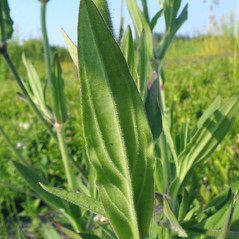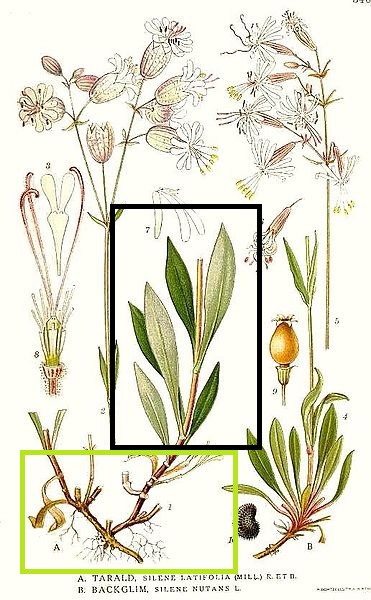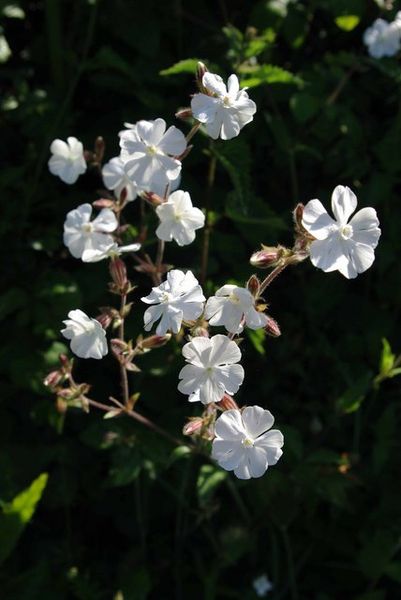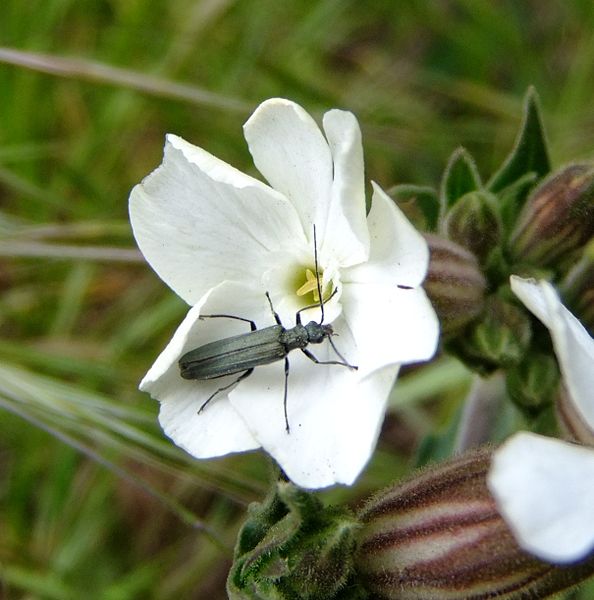Adaptation
 Angiosperms in general have many adaptations that have been
helpful in their transition to living on land. The development
of organs such as leaves, stems, and roots has been extremely
important. Leaves have increased in size in order to increase
surface area. The larger surface area that leaves provide help
with photosynthesis. Stems function as support for plants which
allow plants to grow to be taller. The image to the right shows
what a leaf of Silene latifolia looks like. It has a
large surface area which helps make this species efficient at
photosynthesis. Leaves are also located opposite from one
another which allows more sunlight to get to leaves towards the
bottom of the plant (OARDC, n.d).
Angiosperms in general have many adaptations that have been
helpful in their transition to living on land. The development
of organs such as leaves, stems, and roots has been extremely
important. Leaves have increased in size in order to increase
surface area. The larger surface area that leaves provide help
with photosynthesis. Stems function as support for plants which
allow plants to grow to be taller. The image to the right shows
what a leaf of Silene latifolia looks like. It has a
large surface area which helps make this species efficient at
photosynthesis. Leaves are also located opposite from one
another which allows more sunlight to get to leaves towards the
bottom of the plant (OARDC, n.d).

Roots function for water and nutrient acquisition as well as support and storage. Silene latifolia has a taproot system which means that there is one thick root that spreads laterally when a plant matures. A taproot allows for the plant to reach water deeper into the ground (Kugler & Parker, 2006). Having a deep taproot is beneficial because it is harder to remove the plant once it is established. This adaptation allows S. latifolia to live in a variety of habitats, mostly being found in disturbed habitats.
The image on the right shows the features of Silene
latifolia. The green box on the image shows the taproot of
Silene latifolia. As previously mentioned, the root is
thick with smaller roots spreading laterally. The image also
shows the opposite leaf pattern as mentioned earlier. This can
be seen within the black box.
 Silene latifolia is a dioecious species,
in which males and females are on separate plants. Both males and females have different adaptations. Males in
this species have flowers open longer to increase the chance
that their flowers are pollinated. The longer the flowers are
open, the higher the chances that pollination will occur. Both
males and females produce a sweet perfume that
attracts the pollinators. The pollinators are more likely to
land on a flower because of its scent and will therefore help
pass on that flower's genes through cross fertilization (Young,
2002). This
adaptation of separate male and female plants is beneficial for
other reasons than just pollination. This
separation allows for genetic recombination and an increase in genetic variation within a population. This genetic
recombination could lead to a plant that has different combinations of
traits that could help increase chances of survival.
Silene latifolia is a dioecious species,
in which males and females are on separate plants. Both males and females have different adaptations. Males in
this species have flowers open longer to increase the chance
that their flowers are pollinated. The longer the flowers are
open, the higher the chances that pollination will occur. Both
males and females produce a sweet perfume that
attracts the pollinators. The pollinators are more likely to
land on a flower because of its scent and will therefore help
pass on that flower's genes through cross fertilization (Young,
2002). This
adaptation of separate male and female plants is beneficial for
other reasons than just pollination. This
separation allows for genetic recombination and an increase in genetic variation within a population. This genetic
recombination could lead to a plant that has different combinations of
traits that could help increase chances of survival.
 Another adaptation that Silene latifolia has is the
time of day and the length of time which flowers are open. Flowers usually open
during evening hours and stay open through mid-morning the next
day. This means that flowers are generally open for more than 12
hours which allows for a variety of species, both diurnal and
nocturnal, to pollinate this species. The length of which these
flowers are open is also beneficial because it allows a greater
amount of time in which pollination can occur. Because of this,
there is a very high chance that a flower will be pollinated.
Most pollination does occur throughout the night and the primary
nocturnal pollinators are noctuid and sphingid moths. Diurnal
pollinators are bees, flys and wasps (Young, 2002).
Another adaptation that Silene latifolia has is the
time of day and the length of time which flowers are open. Flowers usually open
during evening hours and stay open through mid-morning the next
day. This means that flowers are generally open for more than 12
hours which allows for a variety of species, both diurnal and
nocturnal, to pollinate this species. The length of which these
flowers are open is also beneficial because it allows a greater
amount of time in which pollination can occur. Because of this,
there is a very high chance that a flower will be pollinated.
Most pollination does occur throughout the night and the primary
nocturnal pollinators are noctuid and sphingid moths. Diurnal
pollinators are bees, flys and wasps (Young, 2002).